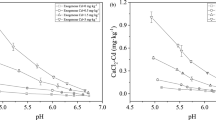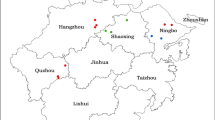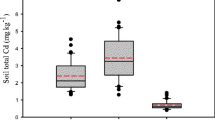Abstract
Organic residue is a good resource of organic matter and nutrients to improve soil physico-chemical properties, but the toxic trace elements, including cadmium (Cd), borne with it may limit its suitability for arable land. This study aimed to develop regression models for Cd critical concentration in the soils amended with Cd-containing organic residue in view of food safety. First, paired data of Cd concentrations in cereal grains and soils from the peer-reviewed literature were collected and screened. Then the plant–soil models between the log10-transformed values of Cd concentrations both in grains and the soils based on soil properties were regressed. The plant–soil model predicted the Cd concentration in the grain (Cdgrain) based on Cd concentration in soil (Cdsoil) and soil properties well with the values of R2 ranging from 0.856 ~ 0.946. Cdsoil and soil pH were the major controlling factors for Cdgrain and explained more than 85.6 percent of variation in Cdgrain. At last, the critical concentration of Cd based on soil property was then back-calculated according to the food safety standard which was presented as continuous or pH-range criteria for Cd-containing organic residue amended soil. With the models derived in this study, a species-specific Cd threshold can be calculated based on soil pH and a default limit value of Cd in grain for food safety. The species-specific Cd threshold will be conducive to scientific application and management of Cd-containing organic residue in agriculture.

Similar content being viewed by others
Data Availability
All data generated or analyzed during this study are included in this article.
References
Adams, M. L., Zhao, F. J., Mcgrath, S. P., Nicholson, F. A., & Chambers, B. J. (2004). Predicting cadmium concentrations in wheat and barley grain using soil properties. Journal of Environmental Quality, 33(2), 532–541.
Adams, S. V., Quraishi, S. M., Shafer, M. M., Passarelli, M. N., Freney, E. P., Chlebowski, R. T., & Neuhouser, M. L. (2014). Dietary cadmium exposure and risk of breast, endometrial, and ovarian cancer in the Women’s Health Initiative. Environmental Health Perspectives, 122(6), 594–600.
Baldantoni, D., Leone, A., Iovieno, P., Morra, L., Zaccardelli, M., & Alfani, A. (2010). Total and available soil trace element concentrations in two Mediterranean agricultural systems treated with municipal waste compost or conventional mineral fertilizers. Chemosphere, 80(9), 1006–1013.
Benjamin, P., Frédéric, G., Mickael, C., Coline, D., Nadia, C., & de Annette, V. (2016). How contamination sources and soil properties can influence the Cd and Pb bioavailability to snails. Enviro. Sci. Pollut. r., 23(4), 2987–2996.
Bingham, F. T., Page, A. L., & Strong, J. E. (1980). Yield and cadmium content of rice grain in relation to addition rates of cadmium, copper, nickel, and zinc with sewage sludge and liming. Soil Science, 130(1), 32–38.
Brus, D. J., Li, Z. B., Jing, S., Koopmans, G. F., Temminghoff, E. J. M., Yin, X. B., & Japenga, J. (2009). Predictions of spatially averaged cadmium contents in rice grains in the Fuyang valley, P.R. China. Journal Environmental Quality., 38(3), 1126–1136.
Cambier, P., Pot, V., Mercier, V., Michaud, A., Benoit, P., Revallier, A., & Houot, S. (2014). Impact of long-term organic residue recycling in agriculture on soil solution composition and trace metal leaching in soils. Science of the Total Environment, 499, 560–573.
Cao, H., & Ikeda, S. (2010). Exposure assessment of heavy metals resulting from farmland application of wastewater sludge in Tianjin, China: The examination of two existing national standards for soil and farmland-used sludge. Risk Analysis,20(5), 613–626.
CEC. (2000). Working Document on Sludge (3rd Draft), Commission of the European Communities Directorate-General Environment, ENV.E.3/LM, Brussels.
Chang, C. Y., Yu, H. Y., Chen, J. J., Li, F. B., Zhang, H. H., & Liu, C. P. (2014). Accumulation of heavy metals in leaf vegetables from agricultural soils and associated potential health risks in the Pearl River Delta South China. Environmental Monitoring and Assessment, 186(3), 1547–1560.
Ciadamidaro, L., Puschenreiter, M., Santner, J., Wenzel, W. W., Madejón, P., & Madejón, E. (2017). Assessment of trace element phytoavailability in compost amended soils using different methodologies. Journal of Soils and Sediments, 17(5), 1251–1261.
Ding, C. F., Zhang, T. L., Wang, X. X., Zhou, F., Yang, Y. R., & Huang, G. F. (2013). Prediction model for cadmium transfer from soil to carrot (Daucus carota L.) and its application to derive soil thresholds for food safety. Journal Agriculture and Food Chemistry, 61(43), 10273–10282s.
Embrandiri, A., Singh, R. P., Hakimi, M. I., & Ramli, A. A. (2012). Land application of biomass residue generated from palm oil processing: Its potential benefits and threats. The Environmentalist, 32(1), 111–117.
European Union (EU). (2006). Draft Risk Assessment Report for Nickel and Nickel Compounds. Section 3.1: Terrestrial Effects Assessment. Draft of May 11, Brussels: European Union.
Filipović, L., Romić, M., Romić, D., Filipović, V., & Ondrašek, G. (2018). Organic matter and salinity modify cadmium soil (phyto)availability. Ecotoxicology and Environmental Safety, 147, 824–831.
GB2762. (2017). Hygienic standard for food [S]. National Health Commission of the People’s Republic of China, China Food and Drug Administration 2017. (in Chinese)
GB4284. (2018). Control standards of pollutants in sludge for agricultural use [S]. State Administration of Market Regulation. Standardization Administration 2018. (in Chinese)
GB15618. (2018). Soil environmental quality- Risk control standard for soil contamination of agricultural land [S]. Beijing, Ministry of Ecology and Environment the People’s Republic of China 2018. (in Chinese)
Gove, L., Cooke, C. M., Nicholson, F. A., & Beck, A. J. (2002). Comparison of the effect of surface application and subsurface incorporation of enhanced treated biosolids on the leaching of heavy metals and nutrients through sand and sandy loam soils. Environmental Technology, 23(2), 189–198.
Granato, T. C., Pietz, R. I., Knafl, G. J., Carlson, C. R., Tata, P., Jr., & Lue-Hing, C. (2004). Trace element concentrations in soil, corn leaves, and grain after cessation of biosolids applications. Journal of Environmental Quality, 33(33), 2078–2089.
Hasan, S. A., Fariduddin, Q., Ali, B., Hayat, S., & Ahmad, A. (2009). Cadmium: Toxicity and tolerance in plants. Journal of Environmental Biology, 30, 165–174.
Khan, M. A., Khan, S., Khan, A., & Alam, M. (2017). Soil contamination with cadmium, consequences and remediation using organic amendments. Science of the Total Environment, 601, 1591–1605.
Koopmans, G. F., Schenkeveld, W. D. C., Song, J., Luo, Y. M., Japenga, J., & Temminghoff, E. J. M. (2008). Influence of EDDS on metal speciation in soil extracts: Measurement and mechanistic multicomponent modeling. Environmental Science and Technology, 42(4), 1123–1130.
Kranner, I., & Colville, L. (2011). Metals and seeds: Biochemical and molecular implications and their significance for seed germination. Environmental and Experimental Botany, 72, 93–105.
Li, Q. (2012). Feasibility and risk assessment study of biosolids agricultural application [D]. Capital Normal University, Beijing. (in Chinese).
Li, Y. M., Rufus, L. C., Siebielec, G., & Kerschner, B. A. (2000). Response of four turfgrass cultivars to limestone and biosolids-compost amendment of a zinc and cadmium contaminated soil at palmerton Pennsylvania. Journal of Environmental Quality, 29(5), 1440–1447.
Lin, J., Zhang, F., & Lei, Y. (2016). Dietary intake and urinary level of cadmium and breast cancer risk: A meta-analysis. Cancer Epidemiology, 42, 101–107.
Liu, D. Q., Zhang, C. H., Chen, X., Yang, Y. Z., Wang, S., Li, Y. J., Hu, H., Ge, Y., & Cheng, W. D. (2013). Effects of pH, Fe, and Cd on the uptake of Fe2+ and Cd2+ by rice. Environmental Science Pollution Research, 20(12), 8947–8954.
Lux, A., Martinka, M., Vaculı, K. M., & White, P. J. (2011). Root responses to cadmium in the rhizosphere: A review. Journal of Experimental Botany, 62, 21–37.
Maestri, E., Marmiroli, M., Visioli, G., & Marmiroli, N. (2010). Metal tolerance and hyperaccumulation: Costs and trade-offs between traits and environment. Environmental and Experimental Botany, 68, 1–13.
Maisonnave, V., Montréjaud-Vignoles, M., Bonni, C., & Revel, J. C. (2002). Impact on crops, plants and soils of metal trace elements transfer and flux, after spreading of fertilizers and biosolids. Water Science and Technology, 46(10), 217–224.
Mcbride, M. B. (2002). Cadmium uptake by crops estimated from soil total Cd and pH. Soil Science, 167(1), 62–67.
Melo, L. C. A., Alleoni, L. R. F., Swartjes, F. A., & da Silva, E. B. (2012). Cadmium Uptake by Lettuce (Lactuca sativa L.) as Basis for Derivation of Risk Limits in Soils. Human and Ecological Risk Assessment: An International Journal, 18(4), 888–901.
Muhammad, I., Puschenreiter, M., & Wenzel, W. W. (2012). Cadmium and Zn availability as affected by pH manipulation and its assessment by soil extraction, DGT and indicator plants. Science of the Total Environment, 416(2), 490–500.
Muhammad, T. R., Rukhsanda, A., Yang, X., Xiao, W. D., Muhammad, K. R., Basharat, A., & Li, T. Q. (2014). Cadmium phytoavailability to rice (Oryza sativa L.) grown in representative Chinese soils. A model to improve soil environmental quality guidelines for food safety. Ecotoxicology Environmental Safety, 103, 101–107.
Norvell, W. A., Wu, J., Hopkins, D. G., & Welch, R. M. (2000). Association of cadmium in durum wheat grain with soil chloride and chelate-extractable soil cadmium. Soil Science Society of America Journal, 64(6), 2162–2168.
Peijnenburg, W., Baerselman, R., & De JagerT, Leenders D, Posthuma L, Veen R V., Groot A. (2000). Quantification of Metal Bioavailability for Lettuce ( Lactuca sativa L.) in Field Soils. Archives of Environmental Contamination Toxicology, 39(4), 420–449.
Pérez, A. L., & Anderson, K. A. (2009). DGT estimates cadmium accumulation in wheat and potato from phosphate fertilizer applications. Science of the Total Environment, 407(18), 5096–5103.
Rashid, I., Murtaza, G., Zahir, Z. A., & Farooq, M. (2018). Effect of humic and fulvic acid transformation on cadmium availability to wheat cultivars in sewage sludge amended soil. Environmental Science Pollution Research, 25(16), 1–9.
Risse, L. M., Cabrera, M. L., Franzluebbers, A. J., Gaskin, J. W., Gilley, J. E., Killorn, R., Radcliffe, D. E., Tollner, W. E., Zhang, H. (2001). Land application of manure for beneficial reuse. White paper on Animal Agriculture and the Environment for National Center for Manure and Animal Waste Management. MWPS, Ames, IA, 38.
Shahid, M., Dumat, C., Khalid, S., Niazi, N. K., Antunes, P. M. C. (2016). Cadmium Bioavailability, Uptake, Toxicity and Detoxification in Soil-Plant System. Reviews of Environmental Ccontamination andToxicology , 241. https://doi.org/10.1007/398_2016_8
Shuman, L. M., Dudka, S., & Das, K. (2002). Cadmium forms and plant availability in compost-amended soil. Communications in Soil Science Plant Analysis, 33(5–6), 737–748.
Simmons, R. W., Noble, A. D., Pongsakul, P., Sukreeyapongse, O., & Chinabut, N. (2008). Analysis of field-moist Cd contaminated paddy soils during rice grain fill allows reliable prediction of grain Cd levels. Plant and Soil, 302(1–2), 125–137.
Tariq, R. M., Rukhsanda, A., Yang, X. E., Xiao, W. D., Stoffella, P. J., Saghir, A., Azam, M., & Li, T. Q. (2014). Phytoavailability of cadmium (Cd) to Pak Choi (Brassica chinensis L.) grown in Chinese soils: a model to evaluate the impact of soil Cd pollution on potential dietary toxicity. PLoS ONE, 9(11), e111461.
Udovic, M., & McBride, M. B. (2012). Influence of compost addition on lead and arsenic bioavailability. in reclaimed orchard soil assessed using Porcellio scaber bioaccumulation test. Journal of Hazardous Materials, 205–206, 144–149.
Ueno, D., Zhao, F. L., & Ma, J. F. (2004). Interactions between Cd and Zn in relation to their hyperaccumulation in Thlaspi caerulescens. Soil Sci. Plant Nutr., 50(4), 591–597.
van Erp, P. J., Houba, V. J. G., & van Beusichem, M. L. (2001). Actual cation exchange capacity of agricultural soils ans ite relationship with pH and content of organci carbon and clay. Communication Soil Science Plant Analysis, 32(1–2), 19–31.
Vries, W. D., Römkens, P. F. A. M., & Schütze, G. (2007). Critical soil concentrations of cadmium, lead, and mercury in view of health effects on humans and animals. Reviews of Environmental Contamination & Toxicology, 191, 91. https://doi.org/10.1007/978-0-387-69163-3_4
Wang, X. P., Shan, X. Q., Zhang, S. Z., & Wen, B. (2004). A model for evaluation of the phytoavailability of trace elements to vegetables under field conditions. Chemosphere, 55, 811–822.
Wang, X. Q. (2012). Ecological Thresholds for Copper and Nickel in Chinese Agricultural Soils [D]. China University of Mining & Technology (Beijing), Beijing. (in Chinese).
Wu, L. H., Zhou, J. W., Zhou, T., Li, Z., Jiang, J. P., Zhu, D., Hou, J. Y., Wang, Z. Y., Luo, Y. M., & Christie, P. (2018). Estimating cadmium availability to the hyperaccumulator, Sedum plumbizincicola in a wide range of soil types using a piecewise function. Science of the Total Environment, 637–638, 1342–1350.
Yong, S. O., Usman, A. R. A., Sang, S. L., SamyA, M. A. E., Bongsu, C., Hashimoto, Y., & Yang, J. E. (2011). Effects of rapeseed residue on lead and cadmium availability and uptake by rice plants in heavy metal contaminated paddy soil. Chemosphere, 85(4), 677–682.
Yu, H. Y., Liu, C. P., Zhu, J. S., Li, F. B., Deng, D. M., Wang, Q., & Liu, C. S. (2016). Cadmium availability in rice paddy fields from a mining area: The effects of soil properties highlighting iron fractions and pH value. Environmental Pollution, 209(1), 38–45.
Zeng, F. R., Ali, S., Zhang, H. T., Ouyang, Y. B., Qiu, B. Y., Wu, F. B., & Zhang, G. P. (2011). The influence of pH and organic matter content in paddy soil on heavy metal availability and their uptake by rice plants. Environmental Pollution, 159(1), 84–92.
Zhuang, Z., Nio-Savala, A. G., Mi, Z. D., Wan, Y. N., & Fangmeier, A. (2021). Cadmium accumulation in wheat and maize grains from china: Interaction of soil properties, novel enrichment models and soil thresholds. Environmental Pollution, 275, 116–127.
Acknowledgements
This work was supported by the National Natural Science Foundation of China [grant numbers. 41701358] and the Key Scientific and Technological Project of Henan Province [grant numbers. 182102311028]. The authors thank all the colleagues and scientists for sharing the dataset of Cd accumulation data the literature. Also the authors thank all the reviewers of this manuscript for their invaluable professional comments.
Funding
National Natural Science Foundation of China,41701358,Key Scientific and Technological Project of Henan Province,182102311028
Author information
Authors and Affiliations
Corresponding author
Ethics declarations
Conflict of Interest
The authors declare no conflict of interest.
Additional information
Publisher's Note
Springer Nature remains neutral with regard to jurisdictional claims in published maps and institutional affiliations.
Supplementary Information
Below is the link to the electronic supplementary material.
Rights and permissions
About this article
Cite this article
Xiao-qing, W., Wenjie, T., Yang, Q.U. et al. Prediction of Cadmium Threshold Using Regression Model for Soils Under Cd-Containing Organic Residue Application. Water Air Soil Pollut 233, 268 (2022). https://doi.org/10.1007/s11270-022-05719-1
Received:
Accepted:
Published:
DOI: https://doi.org/10.1007/s11270-022-05719-1




